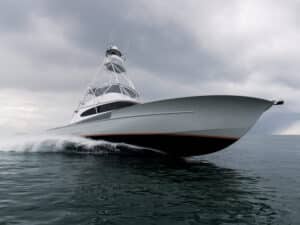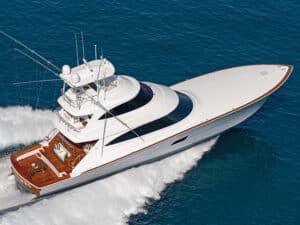What better place to test an offshore boat than Oregon Inlet on North Carolina’s Outer Banks? This channel boasts the worst reputation of any on the East Coast. Charts of the area have so many shipwrecks on them you need a magnifying glass to read the fine print. Our test day, with 3- to 4-foot seas out of the East, seemed positively serene. Nonetheless, shallow water with breaking surf to both sides and horrendous currents afforded a real-world test for this new design.
Design and Construction
It becomes obvious why we refer to boats as “she” when you look at a Buddy Davis design. The Davis 50 blends a remarkable number of complex curves into its hull. If you get a chance, look at the hull from waterline level from dead on the bow. It will amaze you.
Recent advances in design and tooling have allowed Davis to build each boat stronger than ever. For example, the flybridge and deck are now one piece, as is the hull. While the bottom remains solid fiberglass, everything above the waterline now consists of composite for strength without excessive weight and a low center of gravity.
Performance
When you put the throttles forward, the Davis 50 imparts a sensation much like a 5-liter Mustang. You hear a throaty rumble and the acceleration sets you back a step or two if you aren’t holding on and it gets up on plane in short order – eight seconds, to be exact. Our test boat had twin 2000 series, 900-hp DDC/MTUs, but Davis says that next year, most boats will get 1,050-hp MAN diesels. Seems everybody likes to go fast. Don’t get me wrong; the Davis 50 I ran was no slowpoke. It topped out at 33 knots, backed down at 6 knots and turned 180 degrees in four boat lengths at a 25-knot cruise. But speed isn’t this boat’s greatest attribute.
With the conditions that frequent the Outer Banks, boats need to be seaworthy above all else. In fact, that’s exactly what the Carolina-style hull specializes in, and so it goes with the Davis 50. The super-fine forefoot slices through oncoming waves like a deli slicer through bologna. The bow experiences virtually no lugging or deceleration when entering a wave, and the spray blows well out to the sides thanks to hard chines and that signature Carolina flare at the bow.
Down-sea, the Davis 50 tracks straight as an arrow and only heels slightly when waves lift its stern. You expect it to swerve from the boat’s motion, but it doesn’t. Drifting also offers a particularly interesting performance characteristic. The knife-like forefoot acts like a keel, keeping the bow into the wind for a much longer time than usual. It took five or six minutes for the bow to fall off the swell. When it finally reached beam-to, the roll motion proved very comfortable. Discounting the flare, maximum beam on this (and other Davis boats) is at the waterline in the lower half of the boat rather than at the rail. This provides increased roll stability as well as greater interior volume in the engine room.
The channel from Oregon Inlet to Pirate’s Cove contains some hellacious tight turns that must be negotiated at idle speed. Even at 6 knots, response to turning the wheel couldn’t be better and docking provided inch-by-inch control even when not in low-idle.
Flybridge
Perhaps the best aspect to this 50’s flybridge is how easy it is to get there. Yes, the ladder to the flybridge comes farther out into the cockpit than on many boats, but you can easily walk around behind it. It provides superb handholds, an easy climbing angle and a far greater feeling of security. The older I get, the more I appreciate these factors when climbing to a flybridge or tower. Of course, you don’t have to be old to have an accident climbing around on a boat.
As you’d expect, Davis provides plenty of room for guests and storage space. The helmsman enjoys an unobstructed view all around and guests can easily move behind the helm and companion seats. In true 21st-century style, the electronics compartment lifts on rams. While this is certainly a popular feature these days, it leaves no space for the magnetic compass, which consequently gets placed on the forward cowling. Without binoculars, you can’t see the heading on it from the helm. Davis offers a standard wraparound helm console for those who prefer that arrangement.
Fishability
Buddy Davis started his career as a charter captain. He’s never built a boat that didn’t put fishability at the top of the priority list. I noticed that the tumblehome and rubrail outside the cockpit prevent reaching down to the water’s surface when leaning over the rail. Rather than posing a problem, it makes for a very secure feeling – keeping your center of gravity inboard when wiring or releasing a fish.
For a welcome change, the entire bow is non-skid. Whether hanging on to an anchor ball, chunking for tuna or casting livies to striped marlin, the foredeck needs to be usable. Only owners who never go to the bow want a foredeck to be all glossy. And of course, somebody must go to the bow every time the boat docks. Additionally, it’s been my experience that nonskid really knocks down the glare.
Interior
Owners have a choice of several interior layouts. Our boat sported a cabin to port with a double berth and single fore-and-aft. I’d get rid of the single. To starboard it had a small, over/under berth cabin, and an island double on centerline fills the foc’s’l’e. However, in the future, the most popular layout will probably be the full-width master against the engine room bulkhead.
The salon seemed warm and cozy with a short, straight settee to port and L-shaped settee to starboard plus seating in the dinette. Barbara Davis (Buddy’s wife) accepted the challenge of decorating the interior of the factory 50. While a few of the fabrics here and there hint at her gregarious personality, she has come up with some truly innovative and conservative features that I’d love to see used more often. For example, the galley sole – made of strip-planked native cherry – has a flat sealer finish. This lends a very warm “beach house” feeling to the galley while providing non-slip footing and ease of maintenance. Also, drawers tucked away under cabinets have extension slides, allowing them to pull out far enough to actually be usable. Dishware and glasses fit into custom cabinets and shelves, while refrigerator and freezer drawers eliminate the tall, view-blocking standard refrigerator.
Engine Room
Engine access through the step in the cockpit proved a tad tight for my bulk. However, once inside, this 50 provided a surprising amount of workspace – well laid out and clean, with relatively easy access outboard and forward of the engines. I’d prefer to see the generator – currently mounted on the forward bulkhead – moved to the aft bulkhead to keep the noise level in the master stateroom to a minimum.
Everything necessary for routine maintenance can be found right at hand.
Raw-water filters for washdown pumps are located right inside the engine room hatch. Perhaps the best “accessory” can also be found there: An engine-powered bilge pump that uses the engine’s cooling system to pump water out of the bilge. Don’t mistake this feature to mean that Davis boats are more likely to take on water. Every serious offshore boat should have such a system, and very few do from the factory.
Cockpit
This boat offers a cockpit with everything you’d expect on a well-outfitted sport-fisherman. In addition to a gelcoated fish box in the transom, the Davis 50 has a large fish box in the port cockpit sole as well as a lift-out box to starboard. Each of these consists of double doors that open in the center. I’d much prefer single doors, since it always seems the toughest part of boating a fish is opening the fish box.
Though Davis provides the usual complement of rigging station, freezer and tackle storage modules along forward cockpit bulkhead, it now offers customization of these modules. Pick any combination of functions and they’ll be fitted to your layout.
I particularly appreciate the traditional look of Davis boats, and nowhere can this be seen better than the beautiful curve on the inner face of the covering board. (Davis has put such radii on the cap rails of other boats, most notably his 61s.) Not only does this roundness make it more comfortable to lean your leg against, but it also adds a lot to the boat’s overall aesthetics.







